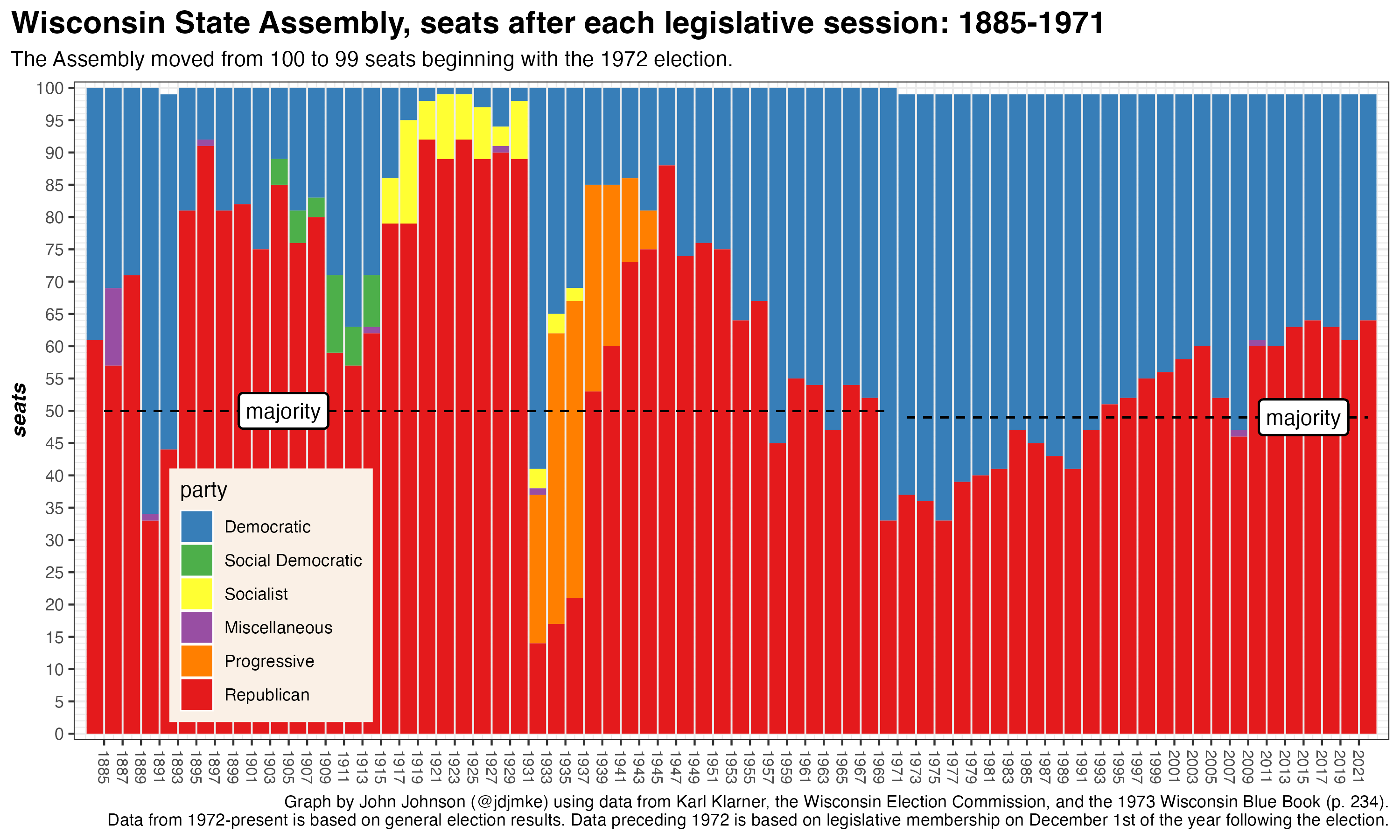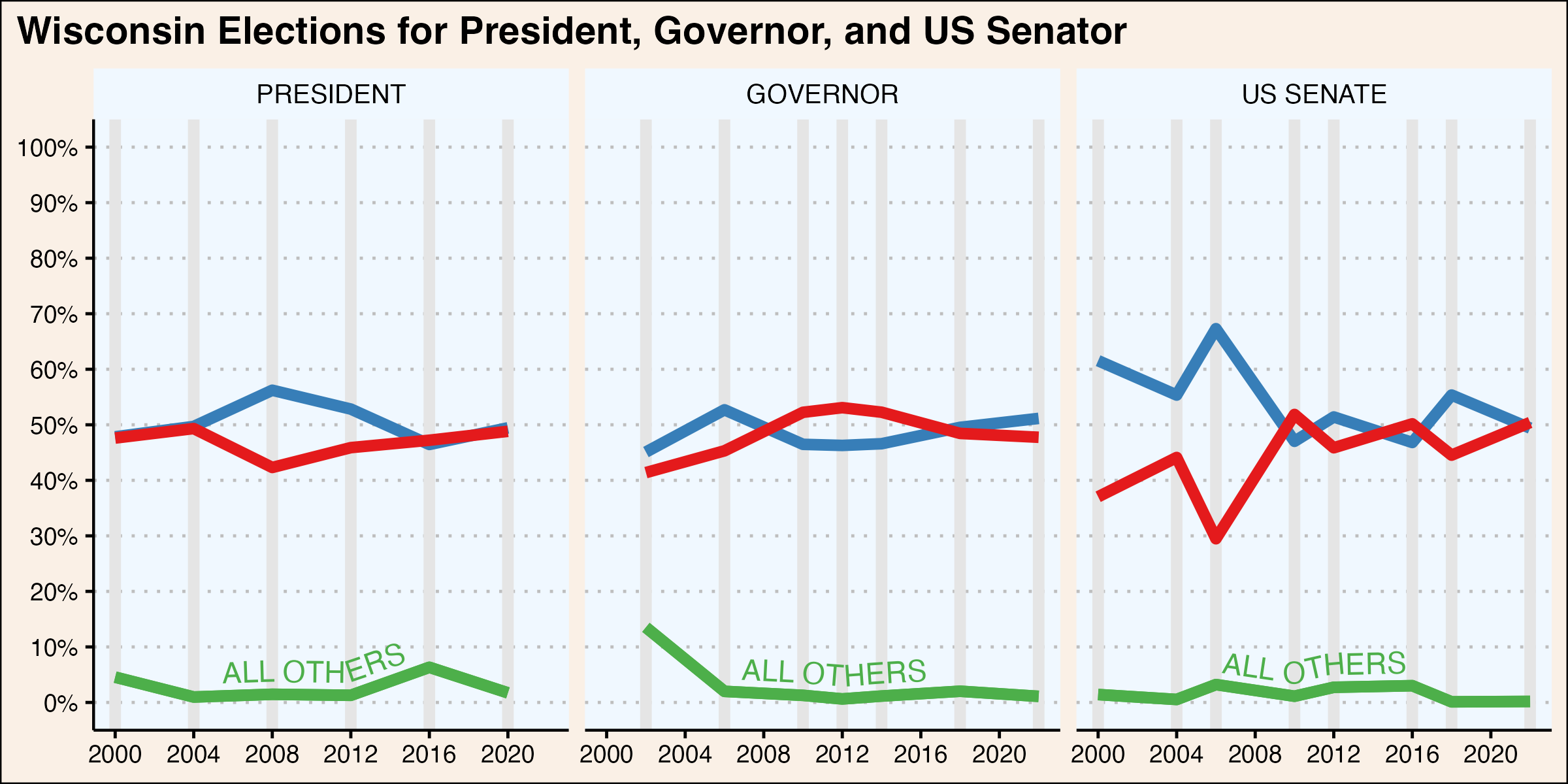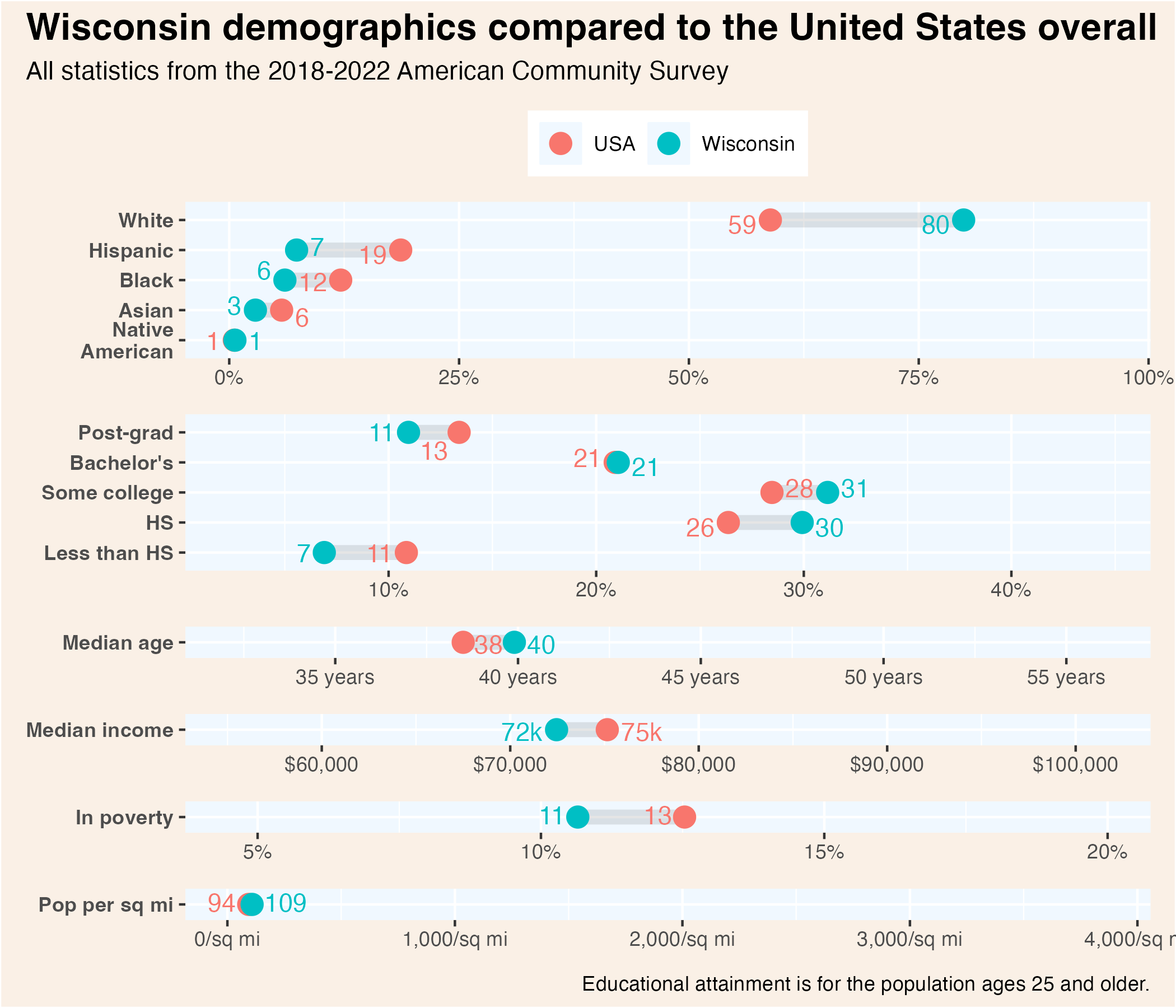
1 Statewide Overview
1.1 the long view
Wisconsin was the “tipping point” state in both the 2016 and 2020 presidential elections. This means that if you lined up every state in order of how it voted, Wisconsin gave both Donald Trump and Joe Biden their crucial 270th vote in the electoral college. In 2020, Biden’s majority was just 20,682 votes out of nearly 3.3 million cast. And in 2016 Trump carried the state by 22,748 votes out of nearly 3 million.
In 2024, Wisconsin was no longer the tipping point state. Although it still voted for the national electoral college winner, the swing toward Trump was the smallest of any swing state. Voter turnout in Wisconsin exceeded that of any other state in 2024.

Razor-thin victories are not new in Wisconsin. Obama won the state handily in both his campaigns, but before that George W. Bush lost by even narrower margins: 11,384 votes in 2004 and 5,708 votes in 2000.
This graph shows the outcome of each presidential election in Wisconsin since the two modern parties emerged in 1860. The Republican Party was originally founded in Wisconsin, and the state consistently favored GOP politicians in the aftermath of the Civil War. From 1860 until the Great Depression, the state voted for the Republican presidential candidate 16 times and the Democratic candidate twice. In 1924, the state backed the third party campaign of former Wisconsin governor Bob La Follette, a Republican-turned founder of the Progressive Party.
Franklin Roosevelt won Wisconsin in his first three campaigns, before narrowly losing the state in 1944. After FDR, the state’s support oscillated back and forth. Wisconsin supported Harry Truman in 1948, then voted Republican in three consecutive elections, helping elect Dwight Eisenhower twice and supporting Richard Nixon in his losing 1960 bid. After voting for Lyndon Johnson in 1964, the state did go on to elect Nixon in both 1968 and 1972.
Following the Watergate scandal, Wisconsin narrowly supported Jimmy Carter over Gerald Ford. Ronald Reagan won the state in both campaigns by similar margins to Nixon. In 1992, independent candidate Ross Perot did relatively well in Wisconsin, receiving about 22% of the vote compared with 19% nationwide. Bill Clinton won the state’s electoral college votes that year, albeit with the lowest share of the vote since Woodrow Wilson defeated Theodore Roosevelt’s third party bid in 1912. Clinton then doubled his margin of victory in 1996.

The balance of power in the Wisconsin State Assembly (elected every two years) provides another glimpse of the state’s political trajectory. Republicans generally held a majority of the Assembly until Roosevelt’s first election in 1932. In fact, during much of the 1920s, the state’s tiny Socialist Party held more seats than the Democratic Party.
The 1932 election ushered in a new majority of Democrats as well as the emergence of the Wisconsin Progressive Party, which was initially larger than the Republican Party. Republicans recovered their majority by the late 1930s and held it until 1958.
The chamber then flip-flopped between parties until 1970 when Democrats took control and held it until 1994. Since 1994, Republicans have won a majority of the State Assembly in all but the 2008 election cycle. They were aided in doing so by an effective gerrymandered map passed by Republicans after they won a trifecta in 2010.
In 2021, the state’s divided government failed to pass new maps, so the state Supreme Court intervened. A complicated series of events followed, eventually resulting in a dramatically different map being used for the 2024 state legislative elections. As a result, Democrats flipped 10 seats in the Assembly and 4 in the State Senate. Although remaining a minority in both chambers, this left the Democratic party in a realistic position to win control of both chambers in the 2026 midterms.

1.2 recent trends
Elections for president, governor and US Senator from Wisconsin have followed different trajectories over the past two decades; although, all have recently converged in a near tie.
Popular incumbent Democrats won landslide victories to the US Senate in 2000, 2004, and 2006. The 2002 gubernatorial race was the first since 1986 not to feature the exceptionally popular Republican politician Tommy Thompson. (Thompson had resigned in 2001 to take a position in George Bush’s cabinet.) With Thompson no longer on the ballot, Democrat Jim Doyle won two terms as governor, by 4 points in 2002 and 7 points in 2006.
The recent Democratic high-water mark came in 2008 when Barack Obama carried the state by 14 points and Democratic candidates won 5 of 8 Congressional seats. Democrats also won a majority of State Assembly seats, which gave them unified control of the governor’s mansion and the both houses of the state legislature.
This high point was short-lived. In 2010, the Tea Party wave carried Republican Scott Walker to victory in the governor’s race and flipped both houses of the state legislature. This allowed Republicans full control of the 2011 redistricting process, and the map they drew helped them to retain control of both houses of the legislature for more than a decade. The Republican trifecta remained in place until Tony Evers defeated Scott Walker in 2018, and legislature remains in GOP control. In fact, Republicans won a supermajority in the State Senate in 2022, after a Republican-drawn map was enacted by the conservative State Supreme Court.
In 2023, the ideological balance of the Wisconsin Supreme Court flipped, and the new liberal majority struck down the previous map (established in 2022). A new map, more favorable to Democrats, was used in 2024 state legislative elections, resulting in a much-reduced Republican majority.

1.3 Supreme Court elections
Wisconsin’s Supreme Court has 7 justices, each of whom are elected to 10 year terms in statewide elections held in April. State law prohibits more than one Supreme Court election from being held in a single year. If a seat becomes vacant, the governor appoints a replacement who serves until the next year in which no court election is already scheduled. If more than two candidates achieve ballot access, a nonpartisan, top-two primary is held in February.
Court elections are formally nonpartisan, but candidates are usually supported by either liberals or conservatives. In recent years, it has become common for the Democratic and Republican parties to endorse and actively campaign on behalf of favored judicial candidates. The liberal and conservative labels indicated in the following graphs and tables are based on widely recognized tendencies, not any formal affiliation.
The results of nonpartisan April judicial elections have also become much more closely correlated with November’s partisan elections. The next graph shows the county-level correlation between each contested Wisconsin Supreme Court election since 1978 and the previous presidential election. In 1978, the correlation between vote for justice and vote for president in 1976 was literally 0.00. By 2025, the correlation was 0.99.

For most of this period, conservative candidates generally enjoyed an advantage in judicial races, largely thanks to the much smaller size of the electorate in April elections. Still, large incumbency effects meant that liberal candidates, such as Shirley Abrahamson, sometimes won landslide victories as well.

1.4 state demographics
Wisconsin’s population is 5.9 million, making it the 20th most populous state. Eighty percent of residents are (non-Hispanic) white compared to 59% in the United States overall. While 19% of US residents are Hispanic or Latino, just 7% of Wisconinites are. The share of Wisconsin residents who are Black or Asian is half the national average, and the share of Native American residents matches the national rate.
Compared to the nation, Wisconsin adults are slightly less likely both to have a post-graduate degree and to have failed to finish high school. Instead, Wisconsin residents are more likely to have just completed high school or to have some amount of college education less than a bachelor’s degree. The median age in Wisconsin is two years older than the national average. The median household income is $3,000 below the national median, but the state’s poverty rate is also 2 percentage points less than the country’s.
